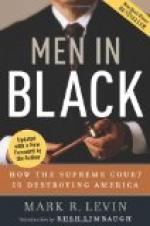Below the witness chair is the stenographer. The former idea of the aged scrivener or court clerk with white hair and green eye shade has vanished. The modern stenographer, who keeps the record of a trial, is probably an energetic young man, who has passed high on the civil service list, knows something about law, is studying for a better position, or is connected with a very profitable stenographers’ business on the outside.
The court proper is divided from the rest of the room by an iron or wooden rail guarded by a jealous court attendant, who is always a strong advocate of court etiquette and very properly maintains the dignity of the court. He is in uniform with a shield or badge of office conspicuously displayed and being taken from the civil service list whereon war veterans and retired firemen or policemen have a preference, is generally of a certain age. Naturally, being old and having to stand so much, he has tender feet, and with the customary effects of all secure and salaried positions, acquires both a slow and shuffling gait and the ordinary characteristics of his class. He is subject to many petty annoyances, foolish questions, repeated inquiries, people talking or arguing, little disorders pursue him on every hand.
The object of the attendant in the court is to maintain order and preserve dignity. They are almost avid in their pursuit of the ignoramus who comes in with his hat on his head or covers himself on going out before he reaches the door. Their salaries are not large but their duties are not arduous. They may seem solicitous to the judge and sometimes overbearing to the litigants and lawyers, but they are only in the position of the supes or ushers in the theater. Yet they are understanding and wise as regards the human drama constantly played before them.
The lighting of the court-room is unusually dramatic. There are no foot-lights, but the best theory of stage lighting is that there should be none. One of the most effective scenes in the modern theater is the court setting in Galsworthy’s Justice. The lighting is indirect and the spots of red and green lights at the judge’s desk, the corners of the jury-box and the shaded ones at the clerk’s elbow, give a remarkable impression of mysterious terror.
Whatever may be the cause, there exists a marked resentment against the courts. Not only is there a complaint as to the cloying technicalities of procedure, the long and fatal delays of the law, the absurd forms and mannerisms of the trial, but underneath them all a fundamental distrust of justice itself. The complaint is heard of the inequality of justice. That there is a law for the poor man and another law for the rich. The stage gives expression to the feeling, and modern literature voices it. The high-priced millionaire escapes and the low-browed pickpocket goes to prison.




